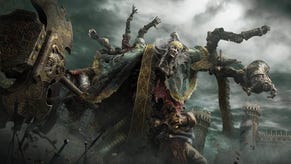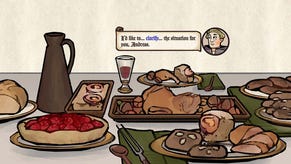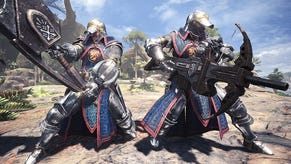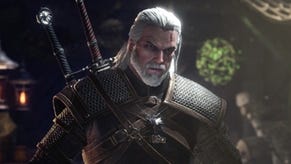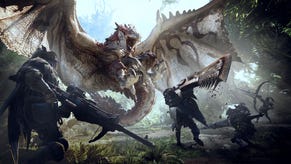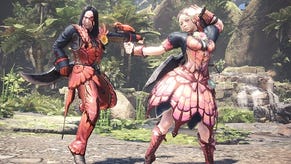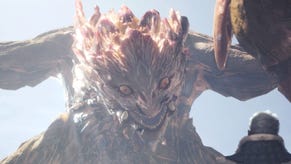If Monster Hunter: World doesn't get you into Capcom's incredible series, nothing ever will
Roll out the Barroth.
Monster Hunter, in case you didn't already know, is great. A series of boisterous action games that charge you with tracking down and felling preposterous, wonderfully realised beasts before skinning them so that you might make a new pair of trousers from their hide then go and hunt some more. It's an intoxicating loop honed over generations, though not without inheriting a few of its own little quirks along the way.
I know that Monster Hunter is great. There are a few million others, whether that's in the series' traditional homeland of Japan or further afield, who know that too. The problem is, Monster Hunter has never had the mainstream, widespread global appeal that Capcom feels it really should have, and that the series most definitely deserves.
And so we have this: Monster Hunter World, the most radical step the series has taken since its inception some 13 years ago. Capcom wants everyone to experience the wonder that is a decent Monster Hunter game, and it doesn't dick around in the process.
You'll know of some of the changes already made. Gone are the partitioned areas of old, making way for a series of dense, detailed mini open worlds. Gone, too, is the divide between online and single-player, with your hunter's quests now all part of one continuous line in which you can recruit friends to fight alongside you in seamless drop-in/drop-out co-op.

There's more in place that makes Capcom's intentions perfectly clear. Items can now be selected via a radial menu, while sprinting is now possible by clicking in the left stick. Whetstones used to sharpen your instrument are now infinite, and take a swipe at a monster and you'll see how much damage has been dealt.
Series conventions have been swept aside, while being carefully preserved so as not to upset the purists. You can switch those numbers off and rely on old-fashioned feedback such as the audible slice of a well-placed blade, toggle items by scrolling through the old-school menu or use the shoulder button to sprint. At times it feels like there's two games sat precariously atop one another, though somehow it still works out.
What it really feels like, ultimately, is a colossal step on from the last mainline entry in the series (that'd be Monster Hunter 4 Ultimate, a game whose directors - Kaname Fujioka and Yuya Tokuda - return for Monster Hunter World). Coming from the confines of a 3DS screen to the expanse of World being played on a PS4 Pro on a 49-inch screen, you understand why there was reluctance to call this one Monster Hunter 5. It's such a leap it may as well be Monster Hunter 7 or 8.
"Monster Hunter has always been based around utilising the hardware we had at hand," Fujioka tells me in a small meeting room at Capcom's Osaka headquarters. "On handheld, it was having these fun games you could take anywhere and play with people around you - they were based on short-term production cycles, too. This time, one of our focuses is having players sit down and relax and immerse themselves deeply in the game. I'm happy to hear that you think it sounds like Monster Hunter 7 or 8! Really, though, it's about making a Monster Hunter that's tailored to the hardware."

And so Monster Hunter World does feel like it's been tweaked for the longer sessions that home consoles are associated with, and been furnished with the hooks that'll keep you coming back for more. Perhaps more pertinently, it feels like a game designed for hardware as it's employed today - where games like Destiny keep you running through their intricately engineered loops with ever-evolving incentives.
In World that amounts to bounties, missions you pick up in the hub area that can be completed over the course of quests and expeditions and that act like MMO's dailies. They're a neat and tidy supplement to Monster Hunter's core loop of grinding out quests until you've acquired a full set of armour from any particular beast.
That loop remains as compelling as ever, embellished with a new set of features only possible on more powerful hardware such as the PlayStation 4 and Xbox One. First there's those environments, dense arenas built with great verticality and incredible detail, some of which can be used to your own advantage. There are plants that heal you, or frogs that can be kicked to let out a paralysing fog. A quick way to success is pitting your mark against the environment - and an even quicker way is pitting monsters against each other.
In one encounter, with the bone-headed Barroth out on the muddy plains of the Wildspire Waste, you can enrage your prey and kite them down towards an ominous looking pit. Aggravate a couple of birds that flock above and the sound will summon forth a Diablos - and all you have to do at that point is run away and hide, perhaps using the all-new ghillie mantle to escape their sight as you watch havoc unfold. It's clash of the titans, Monster Hunter-style, and it's a spectacle few other games are capable of.
"I've been involved with the series since the very beginning," Fujioka says of Monster Hunter: World's guiding concept. "Once we were finished with 4 Ultimate, our basic foundation, the request from producers, was bringing Monster Hunter to a new platform, to these high spec consoles. Looking back at the first promotional materials we had, we realised that Monster Hunter isn't just about enemies - it's these ecosystems, so we thought about how we could express that." Monster Hunter: World does a pretty exquisite job of delivering on its concept, and its environments feel every bit as alive as the beasts that stalk them.
But once again it's the ease with which you're able to engage with it all that emerges as Monster Hunter: World's greatest asset. Given that this is a series that's renowned for being difficult to parse for newcomers unaccustomed to the systems and eccentricities that Monster Hunter has acquired over the years, it's heartening to see how World goes to great lengths to help you make sense of it all.
The on-ramp is more rapid while also more gentle - there are now a series of tutorials for Monster Hunter: World's 14 weapons, as well as a new training arena to help you get to grips with them (perhaps wisely Capcom's chosen not to add any weapon types from the last entry, though each one is now furnished with a new modifier move enabled with the right trigger). Monsters are easier to seek out and track thanks to the scout flies that mark out a path - and, more importantly, you'll come up across behemoths almost right from the start without having to endure hours of pointless gathering missions.

Most importantly, though, is that the magic of Monster Hunter doesn't seem to have been dimmed in the slightest. Across ten hours of playing World I danced with a Tobi-Kodachi as its tail sparked into life, trudged through the slurry of a Barroth as I battered it with a hammer and seen a friend ride rodeo on a Pukei-Pukei as it spat out great globs of poison. The combat is as exquisite as ever - it's just that everything else around it has come a little sharper into focus.
"Really the most important thing we've been focussed on is conveying Monster Hunter to the best ability to the rest of the world," says director Yuya Tokuda. "It's less about changing the design process, but more about focussing deeper on what makes Monster Hunter Monster Hunter. We're a Japanese company making games for a large Japanese market where it's very well received, but it's also about understanding and researching what the world expects of modern games. We do have this Japanese game that we want everyone to enjoy, we're not conscious of trying to appeal to a global audience in that sense - it's about appealing to the world, but also to the individual player."
If there's any justice this will be the game that can spread the word to a wider audience, and that can teach the world the joys of patiently smashing fantastical animals to bits. Capcom's refitting of one of its signature series is at once streamlined and expanded, and it'd take a calamity between now and its release next January to prevent this from being the very best Monster Hunter yet.
This article is based on a press trip to Capcom's offices in Osaka. Capcom covered travel and accommodation costs.



